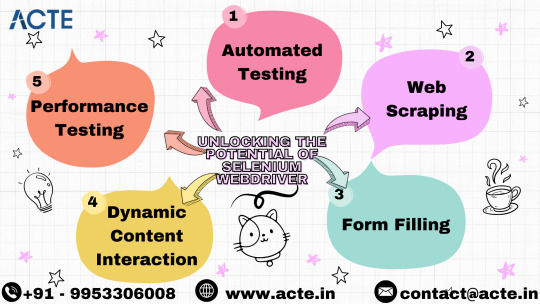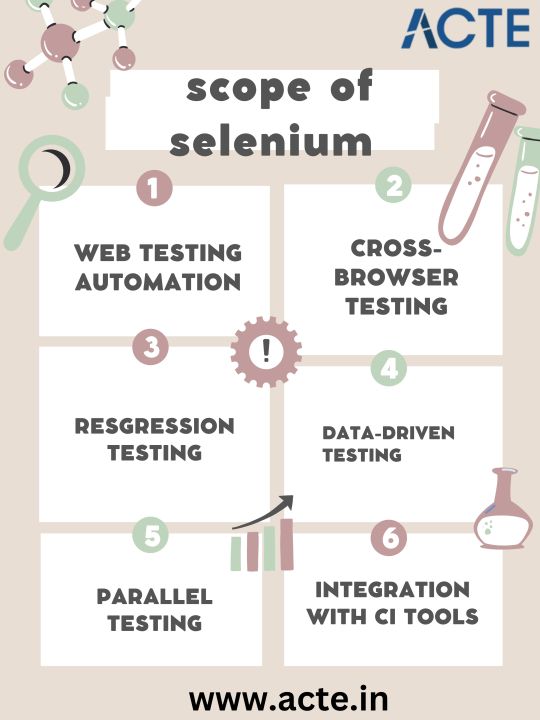Text
Maneuvering Selenium Automation Complexities: Refining your Testing Process
Selenium has managed to carve a solid reputation in the terrain of test automation, endowing both developers and testers with the ability to perform extensive web application testing across myriad browsers and operating systems. However, with such extensive capability comes an array of complex challenges. Be it wrangling with constantly evolving web interfaces or ensuring seamless testing flows across various browsers, Selenium's journey is riddled with obstacles. For those striving to triumph over these Selenium inherited hurdles and polish their testing skills, participating in a notable Selenium training program in Pune could be a potential solution. Such programs serve as a rich reservoir of knowledge and qualifications, preparing you to smoothly sail the rough waters of testing, refine your maintenance strategies, and effectively strengthen your test suites' reliability and performance. In this comprehensive guide, let's uncover the common stumbling blocks of Selenium automation and discuss strategies to outsmart them, thereby elevating your testing pursuits.

Bumps on the Road: Test Instability
One common roadblock in the Selenium landscape is the unpredictable aspect of test results. Tests can fail sporadically due to timing disparities, asynchronous page loadings, or varying element identifiers. Managing these inconsistencies can be resource-intensive and may cast a cloud of uncertainty over the reliability of your tests.
Jumping Over Hurdles: Browser Compatibility
The path to flawless test execution across an array of browsers comes with its share of difficulties. Despite Selenium's wide range of browser support, discrepancies in page renditions and interactions can throw off test homogeneity. It requires meticulous planning and execution to ensure consistent test results across different browser environments.
Digging Through the Sand: Web Element Detection
The crux of stable test scripting revolves around the crucial process of identifying web elements. But in the fast-paced world of dynamic web applications, where elements frequently change identities, crafting effective element detectors is anything but an easy task. Strategic approaches need to be established, leveraging unique markers and selector capabilities to secure dynamic element interactions.
Taming the Beast: Asynchronous Operations
The modern web's inclination towards asynchronous JavaScript for real-time content updates often clashes with Selenium's synchronous nature, resulting in potential timing issues. This calls for strategic synchronization methods, incorporating explicit waits to confirm element readiness before proceeding with scripts.

Stepping Up to the Plate: Test Maintenance
Given the ever-evolving nature of web applications, maintaining test scripts becomes a daunting task. This is particularly true for larger Selenium test suites, as they require continual updates to reflect UI or functional changes. Investing in efficient test maintenance practices, including regular code reviews and regression testing, is paramount for ensuring your test suite's sustainability. Consider joining a Selenium Online Training course for in-depth knowledge on test maintenance and assuring your automated testing suite's reliability.
Selenium's Kryptonite: Performance Testing
As much as Selenium excels in functional testing, performance testing such as load tests demands additional tools and frameworks to accurately depict wide-ranging user interactions. The integration of performance testing within your Selenium workflow is crucial for assessing how your system responds and scales under various conditions.
Ensuring Smooth Transitions: Continuous Integration (CI) Strategies
Incorporating Selenium tests into Continuous Integration pipelines calls for careful orchestration to enable efficient test execution and timely feedback. This includes seamless integration with CI tools, effective management of test environments, and clear communication of outcomes, all essential for optimizing your automation processes for continuous delivery goals.
Navigating the Unexpected: Pop-Ups and Alerts
Unexpected browser pop-ups, JavaScript alerts, or dialogs can pose a challenge since Selenium lacks built-in features to handle these. Incorporating robust error-handling strategies within scripts can alleviate this issue, preventing test interference and allowing for graceful failure.
Stretching the Boundaries: Test Scalability
Expanding the scope of Selenium tests to encompass an extensive range of user scenarios and digital environments comes with its own set of challenges. This is particularly true in the context of large, distributed applications. Practices promoting modularization of tests and parallel execution are key to achieving scalability without compromising on testing accuracy.
In conclusion, gaining mastery over Selenium automation calls for a blend of technical knowledge, effective practices, and a solution-focused mindset to overcome common hurdles. Comprehending these obstacles and implementing suitable countermeasures can empower you to enhance your testing proficiency and consistently deliver high-grade software.
#selenium#selenium training#automation#automation testing#selenium test automation#selenium course#programming#qualityassurance#trends
0 notes
Text
Unveiling the Trials of Excelling in Selenium Automation
In the domain of software testing and quality assurance, automation has emerged as a pivotal force, ensuring efficiency, precision, and agility throughout the development cycle. Among the myriad of automation tools at our disposal, Selenium stands as a beacon for web application testing. Nevertheless, mastering Selenium automation presents its own array of hurdles, necessitating unwavering commitment, expertise, and a profound comprehension of both the tool and the underlying technologies. If you aspire to conquer Selenium for automated testing and web scraping, enrolling in a Selenium Course in Pune can furnish you with the indispensable skills to confront its inherent challenges. In this discourse, we embark on an exploration of the intricacies involved in mastering Selenium automation, shedding light on the obstacles encountered by testers and developers along this expedition.

Understanding Selenium:
Before delving into the challenges, let’s first gain a concise understanding of Selenium and elucidate why it garners widespread adoption within the industry. Selenium serves as an open-source tool employed for automating web browsers across diverse platforms. It furnishes a suite of tools and libraries tailored for automating web applications for testing purposes. With its support for multiple programming languages including Java, Python, C#, and more, Selenium offers flexibility and adaptability, catering to a myriad of project requirements.
Challenges Encountered:
Dynamic Element Locators:
A fundamental challenge in Selenium automation pertains to navigating dynamic element locators. Web applications frequently encompass elements whose attributes such as ID, name, or XPath may undergo dynamic alterations upon page reloads or interactions. Devising robust and dependable locators capable of withstanding such alterations necessitates meticulous deliberation and comprehension of the application’s structure and behavior.
Synchronization Issues:
Synchronization dilemmas arise when the automation script executes actions at a pace exceeding the responsiveness of the web application, resulting in erratic and unreliable test outcomes. Exercising patience for elements to become visible, clickable, or for specific events to transpire is imperative for synchronizing automation scripts with the application’s behavior. Implementing efficacious synchronization strategies such as implicit and explicit waits is imperative for mitigating these issues.
Cross-Browser Compatibility:
Ensuring the compatibility and consistency of web applications across different browsers and versions is paramount. However, each browser may interpret and render web elements disparately, engendering disparities in test results. Mastering Selenium automation entails crafting scripts that are robust and adaptable enough to seamlessly execute across multiple browsers, warranting thorough testing and debugging.

Handling Asynchronous Behavior:
Modern web applications heavily rely on asynchronous JavaScript to augment interactivity and responsiveness. Grappling with asynchronous behavior poses a significant challenge for Selenium testers as it mandates waiting for AJAX requests, animations, or dynamic content to load before executing actions or assertions. Employing techniques such as polling, explicit waits, or leveraging Selenium’s built-in features like WebDriverWait is imperative for effectively managing asynchronous behavior.
Maintenance of Test Suites:
As applications evolve and undergo alterations, maintaining and updating existing test suites becomes an arduous endeavor. Test scripts may succumb to breakages owing to UI modifications, functionality enhancements, or code refactoring, necessitating vigilant monitoring and upkeep. Embracing a modular and maintainable test architecture, implementing version control, and periodically reviewing and refining test code are indispensable practices for ensuring the durability and sustainability of Selenium test suites.
Limited Support for Non-Web Elements:
While Selenium excels in automating web-based interactions, its efficacy diminishes when tasked with automating non-web elements such as desktop applications, mobile apps, or APIs. Integrating Selenium with other tools or frameworks such as Appium for mobile automation or REST-assured for API testing may be imperative for attaining end-to-end test coverage within intricate software ecosystems.
Test Data Management:
Effective management of test data is pivotal for executing comprehensive test scenarios and ensuring adequate coverage. However, generating and maintaining test data sets, particularly for large-scale applications, can prove to be a formidable challenge. Test data may necessitate randomization, parameterization, or extraction from external databases, warranting sophisticated data management strategies and frameworks to streamline the testing process.
Overcoming the Challenges:
Mastering Selenium automation is undeniably an uphill journey, yet with the right approach and resources, these challenges can be surmounted:
Continuous Learning and Skill Development: Remaining abreast of the latest advancements in Selenium and associated technologies through Selenium Online Course, tutorials, and community forums is imperative for augmenting proficiency and staying ahead in the field.
Collaboration and Knowledge Sharing: Engaging with peers, participating in online communities, and attending industry conferences foster knowledge sharing and impart valuable insights into best practices and emerging trends in Selenium automation.
Robust Test Design and Architecture: Devoting time to designing scalable, maintainable, and reusable test frameworks tailored to the specific needs of the project minimizes maintenance overhead and amplifies the reliability and efficiency of automation scripts.
Comprehensive Testing Strategy: Integrating Selenium automation with other testing approaches such as unit testing, API testing, and performance testing facilitates comprehensive test coverage, enabling the identification of defects early in the development lifecycle and ensuring the overall quality of the software product.
Automation Infrastructure Setup: Establishing a robust automation infrastructure encompassing CI/CD pipelines, version control systems, and test management tools streamlines the execution and management of automated tests, fostering collaboration and efficiency within the development team.
Conclusion:
Mastering Selenium automation epitomizes a voyage that demands resilience, dedication, and a readiness to confront challenges and glean insights from setbacks. By comprehending the nuances of Selenium, embracing best practices, and harnessing the abundant resources available within the testing community, testers and developers can transcend obstacles and harness the full potential of automation to deliver high-quality software products that resonate with the exigencies of today’s dynamic and competitive market landscape.
#selenium#selenium training#automation#automation testing#selenium test automation#selenium course#programming#qualityassurance#trends
0 notes
Text
Exploring the Dynamic World of Selenium Careers: Opportunities, Progression, and Community
In today's digital age, where automation is revolutionizing industries across the globe, careers in software testing have emerged as vibrant and dynamic pathways. Among the various tools and frameworks available for software testing, Selenium stands out as a cornerstone technology. Selenium, an open-source tool, has become the go-to choice for automation testing due to its versatility, robustness, and active community support. Wishing to succeed in a job related to selenium? Enroll in a respectable Selenium course in Pune to acquire the invaluable skills and information required to succeed in automation testing. In this blog, we delve into the multifaceted world of Selenium careers, exploring the plethora of opportunities, avenues for progression, and the thriving community that surrounds it.

The Rise of Selenium: A Testament to Versatility
Selenium's journey began in 2004 as a project by Jason Huggins, aiming to automate browser actions for testing web applications. Over the years, Selenium has evolved into a comprehensive suite of tools, including Selenium WebDriver, Selenium IDE, and Selenium Grid, catering to different aspects of automated testing.
One of the key factors contributing to Selenium's popularity is its compatibility with multiple programming languages such as Java, Python, C#, Ruby, and more. This versatility empowers testers and developers to choose the language they're most proficient in, making Selenium accessible to a wider audience.
Moreover, Selenium's cross-browser compatibility allows testing across various browsers like Chrome, Firefox, Safari, and Edge, ensuring consistent performance across different platforms. Its integration with popular Continuous Integration (CI) tools like Jenkins and TeamCity further enhances its utility in modern software development pipelines.
Exploring Career Opportunities in Selenium
The demand for Selenium skills has surged in recent years, reflecting the industry's increasing reliance on automated testing to accelerate the software development lifecycle. As businesses strive for faster releases without compromising quality, professionals proficient in Selenium automation testing are highly sought after.
Automation Test Engineer: As an automation test engineer, individuals leverage Selenium to design, develop, and execute automated test scripts, ensuring the reliability and functionality of web applications. They collaborate closely with developers and QA teams to identify test cases, implement automation frameworks, and analyze test results.
Quality Assurance (QA) Analyst: QA analysts utilize Selenium to conduct comprehensive testing across web applications, detecting defects, and ensuring compliance with requirements. They play a crucial role in maintaining product quality, identifying areas for improvement, and optimizing testing processes through automation.
SDET (Software Development Engineer in Test): SDETs combine software development skills with testing expertise to create robust automation frameworks using Selenium. They participate in all stages of the software development lifecycle, from design and coding to testing and deployment, with a focus on testability and reliability.
Automation Architect: Automation architects are responsible for designing scalable and maintainable automation frameworks tailored to the specific needs of their organizations. They define best practices, select appropriate tools and technologies, and provide guidance to teams for effective test automation implementation, with Selenium often being a cornerstone of their strategies.
Progression and Growth Opportunities
A career in Selenium offers abundant opportunities for growth and advancement, driven by continuous learning and skill development. Professionals can enhance their expertise in Selenium through various means:
Advanced Training and Certification: Completing advanced Selenium courses and obtaining certifications like Selenium Online Training Certification or ISTQB (International Software Testing Qualifications Board) certification demonstrates proficiency and opens doors to higher-level roles.

Specialization in Testing Domains: Diversifying skills by specializing in specific testing domains such as performance testing, security testing, or mobile testing, while still leveraging Selenium for automation, broadens career prospects and enables professionals to address diverse challenges.
Contributions to Open Source Community: Active participation in the Selenium open-source community by contributing code, sharing knowledge through forums, or participating in conferences and meetups not only enriches one's expertise but also fosters professional networking and visibility.
Transition to Leadership Roles: With experience and expertise, Selenium professionals can transition into leadership roles such as Test Manager, QA Lead, or Automation Manager, where they oversee testing strategies, mentor junior team members, and drive organizational initiatives for quality excellence.
The Thriving Selenium Community: Collaboration and Support
Central to the success and evolution of Selenium is its vibrant community of developers, testers, and enthusiasts who collaborate, share insights, and support each other in harnessing the full potential of Selenium. The Selenium community encompasses various platforms and resources:
Selenium Official Website and Documentation: The Selenium official website serves as a comprehensive resource hub, offering documentation, tutorials, and guides for getting started with Selenium and mastering its features.
Online Forums and Discussion Groups: Platforms like Stack Overflow, Reddit, and the Selenium Google Group facilitate discussions, troubleshooting, and knowledge sharing among Selenium practitioners worldwide.
Conferences and Meetups: Selenium-focused conferences and meetups provide opportunities for networking, learning from industry experts, and staying updated on the latest trends and advancements in Selenium and test automation.
GitHub Repositories and Open Source Projects: Numerous open-source projects and repositories on platforms like GitHub host Selenium-related code, libraries, and extensions contributed by the community, fostering collaboration and innovation.
Conclusion: Embracing the Selenium Journey
In conclusion, embarking on a career journey in Selenium opens doors to a dynamic and rewarding realm of opportunities, characterized by versatility, progression, and community collaboration. Whether you're starting as a novice tester or aiming for leadership roles, Selenium equips you with the tools and resources to thrive in the ever-evolving landscape of software testing.
By harnessing the power of Selenium, embracing continuous learning, and actively engaging with the Selenium community, you can chart a fulfilling career path while contributing to the advancement of software quality and innovation. As technology continues to evolve, Selenium remains at the forefront, empowering testers and developers worldwide to drive excellence in software testing and delivery.
#selenium#automation#automation testing#selenium test automation#selenium training#selenium course#programming#coding#technology
0 notes
Text
The Road to Selenium Excellence: A Manual Tester's Guide to Automation
In the dynamic landscape of software testing, manual testers often find themselves at a crossroads as the industry increasingly leans towards automation. However, far from being left behind, manual testers have a unique opportunity to embrace automation and enhance their skills through tools like Selenium. Mastering Selenium as a manual tester might present initial hurdles, but through dedication and consistent practice, undertaking a Selenium Course in Pune can cultivate essential automation expertise. This blog serves as a comprehensive guide for manual testers looking to embark on the journey to Selenium excellence, exploring the transition from manual testing to automation and providing insights into mastering Selenium WebDriver.

Chapter 1: Embracing the Shift Towards Automation
Manual testing has long been the foundation of software quality assurance, with testers meticulously executing test cases and uncovering defects. However, as software development cycles shorten and the need for faster feedback intensifies, automation testing has emerged as a crucial component of the testing process. By automating repetitive tasks and executing tests rapidly, automation testing accelerates the testing process and improves overall efficiency.
For manual testers, embracing automation represents an opportunity to adapt and evolve in an ever-changing industry. While the transition may seem daunting, mastering automation tools like Selenium can open up new avenues for growth and career advancement.
Chapter 2: Understanding the Power of Selenium
Selenium is a powerful open-source automation testing tool widely used for web application testing. It provides a suite of tools for automating web browsers across different platforms and browsers. Selenium WebDriver, in particular, enables testers to write automated tests in various programming languages, making it accessible to testers with diverse backgrounds.
Selenium WebDriver interacts with web elements on a page, simulating user actions such as clicking buttons, entering text, and validating results. Its versatility and flexibility make it the preferred choice for automation testing in the industry.
Chapter 3: Transitioning from Manual to Automation
The transition from manual testing to automation requires a shift in mindset and skill set. While manual testers bring valuable domain knowledge and testing experience to the table, they need to acquire proficiency in programming languages supported by Selenium, such as Java, Python, or C#.
Learning the fundamentals of programming, including variables, loops, conditional statements, and functions, lays the foundation for writing effective test scripts in Selenium WebDriver. Selenium Online Training, documentation, and community forums are valuable resources for manual testers looking to upskill in automation.
Chapter 4: Mastering Selenium WebDriver
Mastering Selenium WebDriver is essential for achieving excellence in automation testing. Testers should start by familiarizing themselves with basic WebDriver commands, such as opening a browser, navigating to a webpage, and locating elements on the page.
As testers gain proficiency, they can progress to more advanced topics, including handling dynamic web elements, interacting with forms, managing browser windows, and implementing synchronization techniques to ensure test stability and reliability. Hands-on practice is crucial for honing Selenium skills and gaining confidence in writing automated tests.

Chapter 5: Writing Effective Test Scripts
Writing maintainable and reusable test scripts is a hallmark of Selenium excellence. Testers should follow best practices such as using descriptive and meaningful element locators, organizing test code into modular functions, and implementing error handling mechanisms to enhance the robustness of test scripts.
Test automation frameworks like TestNG or JUnit can further improve the efficiency and scalability of test scripts by providing features such as test grouping, parallel execution, and reporting capabilities.
Chapter 6: Embracing Test Automation Best Practices
Effective automation testing goes beyond writing code; it involves adopting best practices to maximize efficiency, reliability, and maintainability. Testers should prioritize test cases for automation based on factors such as frequency of execution, criticality, and complexity.
Collaboration with developers and other stakeholders is essential for aligning automation efforts with business goals and ensuring comprehensive test coverage. Regular reviews and updates to test scripts are necessary to adapt to changes in the application and maintain the relevance of automated tests.
Chapter 7: Advancing Skills and Exploring New Frontiers
The journey to Selenium excellence is a continuous learning process that offers endless opportunities for growth and exploration. Testers should seek to expand their automation skills by exploring advanced topics such as test data management, cross-browser testing, and integrating Selenium with other tools and frameworks.
Staying updated with the latest trends and technologies in automation testing, such as containerization, continuous integration, and artificial intelligence, can further enhance testers' capabilities and future-proof their careers in the rapidly evolving field of software testing.
Conclusion:
The road to Selenium excellence is paved with dedication, perseverance, and a willingness to adapt to change. For manual testers, embracing automation represents not just a career advancement but a transformative journey towards becoming automation experts. By mastering Selenium WebDriver, writing effective test scripts, and embracing automation best practices, manual testers can elevate their skills and contribute significantly to the success of software development projects. With determination and a commitment to continuous learning, manual testers can navigate the road to Selenium excellence and emerge as valued automation testing professionals in the ever-evolving landscape of software testing.
0 notes
Text
Selenium Mastery Unlocked: A Comprehensive Real-Time Project Guide
In the dynamic realm of software testing and automation, Selenium stands as a beacon of efficiency and reliability. Its versatility, coupled with its open-source nature, has made it the go-to choice for automating web applications across various platforms and browsers. However, mastering Selenium isn't just about learning its syntax and commands; it's about understanding its application in real-world scenarios. Consider enrolling in a Selenium Course in Pune for in-depth practical exposure and competent coaching if you want to study Selenium with a practical project. In this comprehensive guide, we'll delve into the depths of Selenium mastery through a hands-on, real-time project approach.
Introduction to Selenium:
Before we dive into the intricacies of real-time projects, let's briefly acquaint ourselves with Selenium. Selenium is a powerful tool primarily used for automating web browsers. It provides a set of tools and APIs for web application testing across multiple platforms and browsers. With Selenium, testers can automate repetitive tasks, perform regression testing, and ensure the quality and reliability of web applications.
Why Real-Time Projects Matter:
While theoretical knowledge of Selenium is essential, real-time projects offer a practical understanding of its usage in actual scenarios. Real-time projects simulate the challenges and complexities testers encounter in the industry, providing invaluable experience and skill development. By working on real-time projects, aspirants can bridge the gap between theory and practice, honing their problem-solving abilities and enhancing their proficiency in Selenium.
The Structure of a Real-Time Project:
A well-structured real-time project encompasses several key components:

Project Definition: Clearly define the scope, objectives, and requirements of the project. Identify the web application to be automated and outline the functionalities to be tested.
Environment Setup: Set up the testing environment, including installing necessary software such as Selenium WebDriver, configuring browsers, and integrating with testing frameworks like TestNG or JUnit.
Test Planning: Develop a comprehensive test plan outlining test scenarios, test cases, and test data. Consider edge cases, boundary conditions, and various user interactions to ensure thorough test coverage.
Test Automation: Write automated test scripts using Selenium WebDriver and the chosen programming language (such as Java, Python, or C#). Implement page object model (POM) design pattern for better maintainability and scalability.
Execution and Reporting: Execute the automated test scripts against the web application, capturing test results and generating detailed reports. Analyze test results to identify defects and regressions.
Maintenance and Optimization: Maintain the test automation suite by updating scripts, handling changes in the application under test, and optimizing test execution for efficiency and reliability.
A Step-by-Step Guide to Selenium Mastery:
Now, let's embark on a journey towards Selenium mastery through a step-by-step real-time project guide:
Step 1: Project Setup and Environment Configuration
Begin by setting up your development environment. Install necessary software such as Java Development Kit (JDK), Integrated Development Environment (IDE) like Eclipse or IntelliJ IDEA, and Selenium WebDriver libraries. Configure browser drivers for Chrome, Firefox, or any other browser you intend to automate.
Step 2: Understanding the Application Under Test (AUT)
Familiarize yourself with the web application you'll be automating. Explore its various functionalities, user workflows, input forms, and validation mechanisms. Identify critical areas that require thorough testing.
Step 3: Test Planning and Scenario Identification
Develop a test plan based on the requirements and functionalities of the application. Identify test scenarios covering both positive and negative scenarios. Define test data and expected outcomes for each scenario.
Step 4: Implementing Page Object Model (POM)
Adopt the Page Object Model design pattern to create a modular and maintainable test automation framework. Separate page classes represent individual web pages or components, encapsulating the locators and methods to interact with them.
Step 5: Writing Test Scripts
Write test scripts using Selenium WebDriver and your preferred programming language. Utilize the methods provided by WebDriver to perform actions such as clicking buttons, entering text, selecting options, and verifying elements.
Step 6: Executing Tests and Reporting
Execute the automated test scripts against the application under test. Use testing frameworks like TestNG or JUnit for test execution and reporting. Generate detailed test reports highlighting test results, pass/fail statuses, and any encountered exceptions. Consider enrolling in Selenium Online Training if you want to gain a comprehensive understanding of how test framework implementation is done.

Step 7: Maintenance and Continuous Improvement
Regularly maintain and update your test automation suite to adapt to changes in the application or its environment. Refactor code for better readability, maintainability, and performance. Continuously seek opportunities to enhance your automation framework and testing processes.
Conclusion:
Selenium mastery isn't achieved overnight; it's a journey of continuous learning and refinement. By immersing yourself in real-time projects and hands-on experiences, you'll gain the skills and expertise needed to tackle complex automation challenges with confidence. Embrace the process, stay curious, and never stop exploring the endless possibilities that Selenium automation offers. Start your journey today and unlock the full potential of Selenium mastery!
In conclusion, mastering Selenium goes beyond mere theoretical knowledge. Real-time projects offer a practical understanding of Selenium's application in real-world scenarios, thereby honing one's skills and proficiency. By following a structured approach and delving into hands-on experiences, aspirants can unlock the full potential of Selenium automation and emerge as adept professionals in the field of software testing and automation.
0 notes
Text
Unleash the Power of Selenium: Exploring New Features and Enhancements
Selenium has long been the cornerstone of automated web testing frameworks, providing users with a powerful toolset for driving browsers and simulating user interaction with web applications. Over the years, Selenium has evolved, adding new features and enhancements to stay relevant and powerful in the continuously changing landscape of web development and testing. The most recent versions of Selenium have introduced a host of improvements that have the potential to transform the way developers and testers work with web automation.
Historical Perspective on Selenium’s Evolution
Before delving into the latest features, let’s take a quick look back at Selenium's journey. Selenium first broke ground with Selenium Core and its innovative use of JavaScript for controlling browsers. Later, Selenium Remote Control (RC) addressed the same-origin policy issues by acting as an HTTP proxy. Subsequently, Selenium WebDriver merged with the Selenium project, and Selenium 2.0 was born, which provided a more cohesive and object-oriented API.
Selenium 3.0 brought compliance with the WebDriver standard, and lastly, Selenium 4.0 has emerged with the most exciting updates that ensure Selenium stays at the forefront of web application testing.

Selenium 4: A New Era Begins
With the release of Selenium 4, there are several features and enhancements which are particularly interesting:
1. The W3C WebDriver Standardization
Selenium 4 fully aligns with the W3C WebDriver protocol, which means a more consistent and stable automation experience across different web browsers. This upgrade makes Selenium tests less flaky and more predictable in their interactions with browser APIs.
2. The Enhanced Selenium Grid
Selenium Grid has been redesigned from the ground up to offer a more user-friendly experience. It now supports Docker out of the box, making the deployment of the grid in containers simpler and more scalable. With the ability to deploy on Kubernetes, it ensures high availability and enables more efficient parallel test execution.
3. Improved APIs and Documentation
With updates to the Selenium API, handling new browser features like Shadow DOM has become easier. The comprehensive documentation has also been updated, making it easier for new testers to learn Selenium and for existing users to upgrade their knowledge.
4. Observability and Traceability
Through better logging and the inclusion of hooks for observability, testers can gather more data about test runs. This allows for more in-depth analysis in case of test failures, substantially reducing debugging time.
5. New Browser Options and Controls
New browser options and services in Selenium 4 allow for more fine-grained control. Testers can easily set up browser specific options using native methods to control headless modes, window sizes, and specific capabilities.
Diving Deeper into Selenium 4's Offerings
Now that we've covered the high-level features let’s delve deeper into what each of these features brings to the automation table.

W3C WebDriver Protocol Compliance
In Selenium 4, WebDriver is completely W3C standardized. This means that communication between your test scripts and the browser driver (be it ChromeDriver, GeckoDriver, etc.) follows a standardized protocol. One of the significant benefits of this change is the reduced ambiguity in WebDriver commands' interpretation across different browsers, leading to more consistent cross-browser testing.
The Grid, Redesigned
The Selenium Grid now adds a dashboard that gives testers a real-time view of what is happening in the grid. It now also supports IPV6 and introduces better support for Docker. If you're in a CI/CD pipeline, the revamped Grid offers better integration, making it easy to fluidly integrate Selenium tests.
Upgraded Selenium APIs
Selenium 4 introduces new APIs and deprecates some old ones, aiming to provide an intuitive way to write tests. For instance, the RelativeLocator methods are a game-changer. These methods allow locating an element based on its relation to another element, making tests easier to read and write.
WebElement passwordField = driver.findElement(RelativeLocator.with(By.tagName("input")).below(By.id("username")));
This example locates the password field input box that is just below the username field, illustrating the ease with which human-readable tests can now correspond to visual page layout.
Enhanced User Interactions
The Actions class has always been pivotal for simulating complex user gestures. Selenium 4 brings improvements to this API, allowing for more complex actions sequences, which are now also compliant with the W3C WebDriver specification. This guarantees more accurate interaction simulation, and actions like click, double click, drag and drop are more reliable across different browsers.
Observability and Traceability
In a complex test scenario, it can be challenging to understand why a test has failed. Selenium 4 makes an impressive stride with improved logging and request tracing. By using hooks, testers now have the ability to plug into the life cycle of requests made by the browser driver. This expanded observability helps identify and troubleshoot issues more effectively.
Browser Specific Options and Controls
Selenium 4 allows for setting up bi-directional connections to browsers via the CDP (Chrome DevTools Protocol) for Chrome and Edge, and via the Fission for Firefox. This enables tests to listen to browser events and even to alter browser behavior. It’s an assuring feature to have when one needs to simulate network conditions, intercept HTTP requests, or take advantage of the many other capabilities that these protocols offer.
Conclusion: Stay Ahead with Selenium
Selenium's new features and enhancements address many of the challenges testers face in the modern web development ecosystem. With these capabilities, Selenium solidifies its position as a versatile and robust framework for automated browser testing.
The continuous evolution of Selenium ensures that it remains a relevant, powerful, and dependable tool for QA teams around the globe. Whether you are a seasoned Selenium veteran or new to the world of automated testing, Selenium 4 offers the features and flexibility you need to deliver high-quality web applications with confidence.
Keeping abreast of Selenium’s new features can be a game-changer for your testing career or your company’s product quality. It’s not just a tool; it’s a powerhouse for web automation, which when leveraged properly, can provide outstanding results.
As we expect further developments and enhancements from the Selenium project, the automation realm waits excitedly. The power to script comprehensive tests which mimic real-world user behavior has never been more accessible. With Selenium 4, quality assurance is not just ensured; it’s enhanced.
Testing professionals and development teams, get ready to embrace these changes and elevate your testing frameworks. By incorporating these new capabilities into your daily workflows, you will witness greater efficiency, accuracy, and, ultimately, software releases that shine in quality and user experience.
Unleash the full potential of your testing capabilities—unleash the power of Selenium 4.
#selenium#selenium training#automation#automation testing#qualityassurance#programming#software testing
0 notes
Text
Journey into Web Automation: The Comprehensive Selenium WebDriver Guide
In the vast landscape of software development, the importance of quality assurance and testing cannot be overstressed. As web applications become increasingly complex and integral to our daily lives, the need for efficient and comprehensive testing strategies has become paramount. Enter Selenium WebDriver, a powerful tool that has reshaped the horizon of automated web testing. This blog post embarks on a detailed journey into the world of web automation through the lens of Selenium WebDriver, providing insights, tips, and best practices.
Unveiling Selenium WebDriver
Selenium WebDriver is an open-source automation tool designed specifically for web applications. It allows developers and testers to simulate user interactions with web browsers, such as clicking buttons, filling forms, and navigating through pages, programmatically. Unlike its predecessor, Selenium RC (Remote Control), WebDriver directly communicates with web browsers, offering more robust, faster, and more natural interactions.
The Origins and Evolution
The journey of Selenium WebDriver began as an improvement over its predecessor, aiming to overcome the limitations posed by the JavaScript-based automation of Selenium RC. Its creation marked a significant leap in the field of automated testing, introducing capabilities that were once thought to be challenging to implement, such as handling dynamic web elements more effectively.

A Diverse Ecosystem
Selenium WebDriver stands out not only for its functionality but also for its compatibility with a wide range of programming languages, including Java, C#, Python, Ruby, and JavaScript. This versatility ensures that teams can adopt Selenium WebDriver without needing to venture outside their technological comfort zones.
Setting the Stage: Installation and Setup
Getting started with Selenium WebDriver involves a series of straightforward steps:
Choose a Programming Language: Select a programming language that best fits your team's skill set and project requirements.
Install a Language-Specific Client: Download and install the Selenium WebDriver library specific to your chosen programming language.
Download Browser Drivers: Selenium WebDriver requires drivers to interface with each type of browser. These drivers need to be downloaded and set up in your development environment.
Mastering Selenium WebDriver
Becoming proficient with Selenium WebDriver requires understanding its core concepts and mastering its vast array of functionalities.
Locating Elements
One of the fundamental skills in web automation is identifying and interacting with the elements on a web page. Selenium WebDriver provides various strategies for locating elements, such as ID, name, class name, CSS selector, and XPath. Each method has its use cases, and selecting the most effective strategy can significantly impact the robustness of your tests.
Handling Dynamic Content
Modern web applications often contain dynamic content, which can pose challenges for automated tests. Selenium WebDriver offers strategies to manage these scenarios, such as explicit and implicit waits. These waits allow your tests to dynamically adapt to the content, ensuring interactions only happen when elements are ready.
Cross-Browser Testing
Ensuring compatibility across multiple browsers is a critical aspect of web development. With Selenium WebDriver, you can run your tests on different browsers with minimal changes to your code. This capability facilitates a more extensive testing coverage, catching browser-specific issues early in the development cycle.
Advanced Interactions
For more complex scenarios, Selenium WebDriver provides the Actions class, which supports advanced interactions such as drag-and-drop, hovering, and keyboard actions. These interactions mimic real-user behavior more closely, allowing for thorough testing of the application's UI and functionality.

Challenges and Solutions
While Selenium WebDriver is an immensely powerful tool, it comes with its set of challenges:
Flakiness and Reliability: Tests can sometimes be flaky, failing intermittently due to timing issues or environmental factors. Implementing robust wait strategies and ensuring clean test environments can mitigate these issues.
Complexity in Setup and Maintenance: Setting up Selenium WebDriver for a comprehensive test suite across multiple browsers and operating systems can be complex. Leveraging cloud-based testing environments like Sauce Labs or BrowserStack can simplify this aspect.
Beyond Functional Testing
Selenium WebDriver's utility goes beyond simple functional testing. It plays a crucial role in various stages of the development pipeline, including:
Continuous Integration (CI): Integrating Selenium tests into your CI pipeline ensures that new changes do not introduce regressions.
Visual Regression Testing: By capturing screenshots and comparing them against a baseline, Selenium WebDriver can help identify unintended visual changes.
Performance Testing: While not a primary use case, Selenium WebDriver can be used in conjunction with other tools to measure the performance of web applications.
Conclusion: The Path Forward with Selenium WebDriver
Selenium WebDriver has cemented its place as an indispensable tool in the arsenal of web developers and testers alike. Its ability to automate complex web interactions in a natural, user-like manner, coupled with its support for multiple programming languages and browsers, makes it a versatile and powerful solution for web testing challenges.
As web technologies continue to evolve, the journey with Selenium WebDriver is far from over. The community around Selenium is vibrant and continuously working towards making it more robust, user-friendly, and capable of tackling the ever-changing landscape of web development.
By embracing the best practices, persevering through the initial learning curve, and staying engaged with the community, teams can unlock the full potential of Selenium WebDriver, ensuring their web applications meet the high standards of quality, compatibility, and performance required in today's digital world.
0 notes
Text
Mastering the Basics: Your Comprehensive Introduction to Selenium Testing
In the dynamic terrain of software development, delivering flawless products is not just an expectation but a norm. As websites and web applications become increasingly sophisticated, robust testing frameworks like Selenium are the linchpins in achieving impeccable quality. For those new to the concept, Selenium represents a paradigm shift in how we approach testing, ushering in an era of automated, repeatable, and scalable test cases. This blog post is tailored to help you understand and master the basics of Selenium Testing — providing a comprehensive introduction to the world of automation.

What is Selenium?
Selenium is an open-source testing framework specifically designed for web applications. It facilitates the execution of automated tests across various browsers and platforms, making it an integral part of quality assurance strategies. Unlike manual testing, Selenium allows you to write test scripts that mimic user interactions—clicking, typing, navigating—thereby validating the functionality of web applications with precision and efficiency.
The Selenium Family
Selenium isn't just a single tool but a suite of software, each serving different testing needs. Its primary components are Selenium WebDriver, Selenium IDE, and Selenium Grid.
Selenium WebDriver
Selenium WebDriver is the centerpiece of the suite, an API that allows for the creation of browser-based regression automation suites and tests, scaled across different environments.
Selenium IDE
The Selenium Integrated Development Environment (IDE) is an easy-to-install plugin for both Firefox and Chrome that can record, edit, and debug your test cases and even play them back.
Selenium Grid
Selenium Grid allows for concurrent execution of tests across different browsers and environments, dramatically reducing the time it takes to execute your test cases.
The Advantages of Using Selenium
Implementing Selenium offers several distinct benefits, making it the testing framework of choice for many developers and testers:
Cross-Browser Compatibility: It supports all the major browsers, ensuring your web app performs consistently across different user environments.
Language Support: Selenium supports various programming languages including Java, Python, C#, and Ruby, giving testers the flexibility to write tests in the language they are most proficient with.
Community and Support: As an open-source tool, Selenium benefits from a vast community that contributes to its continuous improvement and provides ample support.
Integration: Selenium easily integrates with other software tools, like Jenkins for CI/CD, and testing frameworks, such as TestNG and JUnit, for test management.
Setting Up for Selenium Testing
The journey into Selenium testing starts with setting up the right environment. Here are the steps you need to follow:
Prerequisites
Choose and install the programming language of your preference (e.g. Java, Python). Then, set up your development tools and download the necessary WebDriver binaries for your chosen browsers.
Best Practices for Effective Selenium Testing
To make the most out of Selenium testing, here are some best practices to adhere to:

Test Atomicity: Make sure each test is self-contained and independent of others.
Descriptive Naming: Name test cases clearly and logically.
Explicit Waits: Utilize explicit waits rather than implicit to handle elements that take time to load.
Page Object Model (POM): Implement POM for better maintainability of your test code.
Regular Refactoring: Refactor your test code regularly to improve efficiency and reduce duplication.
Handling Challenges in Selenium Testing
Despite its many benefits, Selenium also presents various challenges—dynamic content handling, browser compatibility issues, and synchronization problems, to name a few. It's critical to stay proactive, keeping up with Selenium's evolving landscape, and using the community's collective knowledge to find solutions.
Conclusion
Selenium Testing has revolutionized the field of automated web application testing. With its extensive browser support, language agnosticism, and community-driven growth, it has cemented its position as the go-to framework for testers worldwide. For any software development professional, mastering Selenium is not just a skill but an essential toolbox for ensuring the delivery of high-quality web applications.
This introduction has just scratched the surface of what's possible with Selenium. As you delve into your journey, remember that constant learning and practice, along with active participation in the Selenium community, will enhance your skills and proficiency. With dedication and perseverance, you will transform from a beginner into a Selenium testing maestro in no time. Embrace the change, and happy testing!
This comprehensive rundown, stretching beyond a thousand words, constructs a sturdy foundation for the aspiring Selenium tester. It opens the gateway to sophisticated test automation and brings you one step closer to becoming adept in this crucial aspect of modern software development.
#selenium#selenium training#selenium test automation#automation#automation testing#trends#tumblr milestone#poets on tumblr
0 notes
Text
Kickstarting Your Selenium Journey: Essential Starting Points
Selenium, known for being a powerful tool in the realm of automated testing, has paved its way to popularity due to its robustness, simplicity, and wide-ranging functionality. But how does one kickstart their journey into the wilds of Selenium? It's a journey that might appear daunting initially, given that Selenium is significantly comprehensive. Looking to advance your career in automation testing? Look into Selenium Training in Chennai for a rewarding learning experience. This comprehensive program provides hands-on training with Selenium, a crucial component for modern testers and developers. By enrolling, you'll develop practical skills and specialized knowledge in automating web applications, positioning yourself for success in the dynamic IT industry. Seize this opportunity to elevate your expertise and propel your career growth. Enroll today to begin your journey toward becoming a skilled Selenium tester. This blog will serve as a roadmap, providing essential starting points to smooth your journey with Selenium.
Introduction to Selenium
Before diving into the depths of Selenium, let's first understand its basics. Selenium is an open-source tool utilized for automating web browsers. It provides a simplified way to script browser actions, hence, it is extensively used in automation testing of web applications.
Selenium supports various programming languages like Java, Python, C#, Ruby, and JavaScript. Although Selenium is most popularly used with Java, its compatibility with multiple languages allows developers and testers to work with the language they are most comfortable with.
Why Use Selenium?
Selenium's popularity is attributed to several reasons:
Open Source: Being open-source, it involves no licensing cost for usage, saving not only time but also financial resources.
Multi-language Support: As mentioned, Selenium supports numerous scripting languages.
Multiple Browsers and Platforms: Selenium can be used across various browsers, including Chrome, Firefox, and Internet Explorer. It is also platform-independent, functioning on Windows, Mac, or Linux.
Parallel Test Execution: Selenium Grid allows the simultaneous execution of tests on different browsers, machines, and operating systems, promoting efficient test execution and reducing test time.
Integration Capability: Selenium can be integrated with tools like TestNG & JUnit for managing test cases and generating reports, and with Maven, Jenkins, and Docker for continuous testing.
Getting Started with Selenium
Embarking on your Selenium journey requires a solid understanding of specific vital aspects.

Learning a Programming Language
While it’s true Selenium supports several languages, it's recommended to kickstart your Selenium journey with Java or Python due to comprehensive support and a vast community base.
Understanding Selenium Tools
Selenium offers different tools for web testing. Familiarizing yourself with these tools is invaluable in your Selenium journey:
Selenium IDE: This integrated development environment allows for tests to be performed against any web browser through record-and-playback techniques. It’s an excellent starting point for beginners but is generally employed only for simpler test cases.
Selenium WebDriver: This tool, a successor to Selenium Remote Control, directly interacts with the browser and is employed for more complex test cases. WebDriver’s ability to execute tests across various browsers is a plus.
Selenium Grid: This tool allows you to perform tests on different machines against different browsers in parallel, drastically reducing the time needed for running in-browser test suites.
Knowledge of HTML, CSS, and JavaScript
While not mandatory, understanding these three pillars of the web is beneficial in writing accurate and efficient tests.
Patience and Practice
Learning Selenium requires patience. Initially, code may behave unexpectedly or tests may fail. This is part of the learning journey — take it slow and continue practicing. Stack Overflow, GitHub, and other online communities can also provide help as you learn.
Tackling Selenium WebDriver
Since Selenium WebDriver forms the core of our Selenium journey, understanding it thoroughly is vital.
Understanding WebDriver's Working
WebDriver makes direct calls to the browser using the browser’s native support for automation. It has framework bindings to interact with the browser in the language of your choice. The test scripts generated communicate with the driver of the specific browser. Discover a multitude of online materials, such as books, tutorials, and Selenium Online Training, to master these languages.

Mastering Locator Strategies
Accurate identification of elements is a significant aspect of automating tests. Selenium WebDriver allows various strategies like ID, Name, Class name, Link text, XPath, and CSS Selector for the same. Familiarize yourself with these strategies, and don't underestimate XPath and CSS Selector’s power!
Understanding WebDriver Methods
An insight into WebDriver methods such as navigating through pages, handling cookies and pop-ups, and SIMULATING mouse events, is essential for efficient scripting.
Moving Ahead and Resources
After getting comfortable with Selenium, look into its integration with tools like TestNG, JUnit, Maven, Jenkins, etc., to further enhance your testing ability.
You can refer to resources such as the SeleniumHQ Documentation, Selenium online to assist you at each step.
Remember, practice and patience are key. The world of Selenium offers immense potential, but it requires resilience to unravel it. Happy testing!
#selenium test automation#selenium#selenium training#selenium course#automation testing#automation#education
0 notes
Text
Unlocking Efficiency: The Top Benefits of Utilizing Selenium for Web Testing
In today's digital age, where websites and web applications are the front door for countless businesses and organizations, ensuring functionality, efficiency, and user satisfaction is paramount. As such, web testing has become an indispensable part of the development process, offering a safeguard against potential errors, usability issues, and performance glitches that could detract from user experience. Among the myriad tools available for web testing, Selenium stands out as a premier choice for developers and testers worldwide. Definitely! If you're dedicated to acquiring practical Selenium skills, I highly recommend considering Selenium Training in Chennai. This comprehensive exploration delves into the numerous advantages of Selenium, illustrating why it is considered a linchpin in web testing.
What is Selenium?
Before diving into the benefits, it's essential to understand what Selenium is. Selenium is an open-source automation tool specifically designed for web applications. It enables testers to write tests in several programming languages, including Java, C#, Python, and Ruby. Selenium can be deployed on Windows, Linux, and macOS, offering a versatile testing solution across different environments. The Selenium suite comprises several tools, including Selenium WebDriver, IDE, and Selenium Grid, each serving distinct testing needs and scenarios.
Unparalleled Flexibility and Compatibility
One of the standout features of Selenium is its unparalleled flexibility and compatibility. Unlike many other testing tools, Selenium supports a wide range of browsers, including Chrome, Firefox, Internet Explorer, and Safari, allowing testers to ensure that web applications function seamlessly across these platforms efficiently. Furthermore, Selenium's support for multiple programming languages enables testers to write scripts in the language they are most comfortable with or the one that best suits their project requirements.

Cost-Effectiveness: Open Source Advantage
The fact that Selenium is open source is a significant benefit. It eliminates the need to invest in costly testing software, making it accessible to businesses of all sizes, from startups to large corporations. The open-source nature of Selenium not only reduces software costs but also fosters a strong community of users and developers who contribute to its continuous improvement and expansion.
Easy Integration and Extensibility
Selenium's design allows easy integration with various development, testing, and continuous integration tools. Whether integrating with tools like Jenkins for continuous integration, Docker for containerization, or TestNG and JUnit for test management, Selenium fits smoothly into the development ecosystem, streamlining the testing process. Additionally, Selenium can be extended with various plugins and libraries to enhance its functionality, making it adaptable to a wide range of testing needs.
Automated Cross-Browser Testing
The digital landscape's diversity, with users accessing websites from myriad devices, operating systems, and browsers, necessitates thorough cross-browser testing. Selenium excels in this area, allowing automated tests to run simultaneously across multiple browsers. This capability saves a considerable amount of time and ensures that a web application delivers a consistent user experience, irrespective of the access point.
Facilitates Agile and DevOps Practices
In the fast-paced world of software development, practices like Agile and DevOps emphasize rapid development cycles and a steady flow of updates and improvements. Selenium, with its capabilities for automation and integration, fits seamlessly into these methodologies. It facilitates faster feedback loops, allowing quicker iterations and the ability to respond to issues in real-time, thereby significantly enhancing productivity and efficiency.
Enhanced Test Accuracy and Efficiency
While necessary in specific scenarios, manual testing is time-consuming and prone to human error. Selenium automates the testing process, reducing the potential for mistakes and increasing the thoroughness of tests. Automated tests can be run repeatedly with consistent accuracy, which is crucial for regression testing and ensuring that new changes or updates do not break existing functionalities.
Empowering Continuous Testing and Delivery
Continuous testing and delivery are essential for maintaining the competitiveness and reliability of web applications. Selenium's automation capabilities enable continuous execution of tests, providing instant feedback on the impact of code changes. This constant loop facilitates a quicker delivery cycle, ensuring that updates can be deployed confidently and with minimal disruption to the user experience. Don't let this opportunity pass by to enhance your Selenium capabilities and advance your career. Enroll in this Selenium Online Training immediately and begin your transformation into a skilled Selenium tester!

Scaling with Selenium Grid
Selenium Grid offers a powerful solution for large-scale projects or applications requiring testing under various conditions. It allows for the parallel execution of tests across multiple machines and browsers, significantly reducing the time for comprehensive testing. This scaling capability ensures that even the most extensive web applications can be thoroughly tested in a fraction of the time it would take using sequential testing methods.
Conclusion
Selenium stands as a beacon of efficiency and effectiveness in web testing. Its array of benefits, from flexibility and compatibility to cost-effectiveness and the facilitation of agile practices, makes it an indispensable tool for developers and testers aiming to deliver flawless web applications. As technology evolves and the demand for high-quality web experiences grows, Selenium's role in ensuring that applications meet these expectations becomes increasingly vital. By harnessing the power of Selenium, businesses and developers can unlock higher efficiency, robustness, and user satisfaction, cementing their competitive edge in the digital marketplace.
#selenium#selenium training#selenium course#docker#junit#selenium test automation#selenium testing#automation#automation testing
0 notes
Text
Discovering the Building Blocks of Selenium in Simple Terms

Selenium IDE (Integrated Development Environment)
Think of Selenium IDE as a special notepad for recording what you do on a website. It’s like a diary that writes down the things you do on the internet. This is a simple way to start testing websites. Selenium IDE (Integrated Development Environment) is the simplest tool in the Selenium Suite. It is a Firefox add-on that creates tests very quickly through its record-and-playback functionality. This feature is similar to that of QTP. It is effortless to install and easy to learn.
Selenium WebDriver
Now, let’s get a little technical. WebDriver is like the engine that makes your testing happen. It’s a set of tools for different computer languages, like Java or Python. These tools help you do things on a website, like clicking buttons or filling out forms, just like a real person. Selenium WebDriver is a browser automation framework that accepts commands and sends them to a browser. It is implemented through a browser-specific driver. It directly communicates with the browser and controls it. Selenium WebDriver supports various programming languages like Java, C#, PHP, Python, Perl, and Ruby.
Selenium Grid
When you want to test on different internet browsers at the same time, that’s where Selenium Grid comes in. It helps you spread your tests across different computers to make sure everything works on different browsers and devices. Hub is a server that accepts access requests from the WebDriver client, routing the JSON test commands to the remote drives on nodes.
Selenium Client Libraries
Remember those tools I mentioned earlier? Client libraries are like special helpers that let you use those tools in your favourite computer language. They help you talk to WebDriver. So, whether you like Java, Python, or something else, you can use Selenium without any problems. The Selenium Client Library consists of various language libraries for Java, Ruby, Python, and other supported languages. JSON denotes Java script Object Notation.
Third-party frameworks and tools
Selenium can do even more when you use it with other tools. These tools help you organise your tests and make them easier to understand. They can also help you test mobile apps and other things. Selenium frameworks based on the functional approach are classified into three main types: Data-driven framework. keyword-driven framework. Hybrid framework.
Browsers and Web Drivers

Selenium is a great tool for testing websites. Its parts, from Selenium IDE for recording what you do to WebDriver for doing things on websites and Selenium Grid for testing on different browsers, work together to make testing easier. With Selenium, you can make sure your websites work well on different browsers and devices. So, next time you want to test a website, remember that Selenium is there to help you. Happy testing! To dive deeper into Selenium and unlock its full potential, consider reaching out to ACTE Technologies, a leading provider of certifications and job placement opportunities in the field of Selenium. Their experienced staff can guide you on your journey to mastering this versatile tool.
2 notes
·
View notes
Text
Learning Selenium by Yourself: A Beginner’s Guide
Selenium helps you do things on the internet automatically. It’s great if you want to test websites, gather data, or just save time by making your computer do web tasks for you. Learning Selenium on your own might seem hard at first, but if you follow our guide, you can do it!
What is selenium?

Here’s how you can start learning Selenium by yourself:
Choose a Programming Language:
First, choose a computer language. You can use Python, Java, or JavaScript. We’ll use Python in this guide because it’s simple and popular. Selenium talks to browsers using different languages. You can choose one you already know or want to learn. Popular ones are Python, Java, and JavaScript. For this guide, we’ll use Python.
Set Up Your Environment:
Before you can use Selenium, you need to set up your computer.
Python: If you don’t have Python, download and install it from the Python website.
Selenium WebDriver: Use a tool called Pip to install Selenium. Open a command prompt and type pip. install selenium.
Web Browser Driver: Selenium needs a special driver for your web browser (like Chrome or Firefox). Download it from the internet and put it where your computer can find it.
Learn Basic Web Concepts:
It’s a good idea to know a little about websites. Learn about things like HTML and CSS. You don’t have to be an expert; just understand how web pages work. It helps to understand some basics about websites. You don’t need to be an expert, but knowing how web pages are built will make it easier to use Selenium.
Explore Selenium Documentation:
Selenium has a big instruction manual. Look at the official Selenium guide for your chosen language. It’ll teach you how to use Selenium to do cool things on the web. Selenium has a guidebook that tells you everything you need to know. Look at the official Selenium guide for Python or the one for your chosen language. It will help you understand how to use selenium.
Practice and Experiment:
Learning Selenium is like learning a sport or a musical instrument. You get better with practice. Start with easy things and work up to harder ones. Try different websites and see what you can make Selenium do. To get better, you have to practice. Start with easy plans and slowly try more challenging things. Try different websites and see what Selenium can do.
Join online communities:
There are lots of people who use selenium and like to help others. Go to websites like Stack Overflow or Reddit to ask questions and share what you learn. There are lots of people online who love selenium. You can find them on websites like Stack Overflow or Reddit. If you have questions, ask them. You can also learn from what others are doing.
Explore advanced topics:
Once you’re comfortable with Selenium, you can learn more advanced things like handling tricky parts of websites or organising your code better. Once you’re comfortable with Selenium, you can learn more advanced stuff, like handling tricky web elements or using a Page Object Model (POM) to organize your code better.
Courses and Tutorials:
If you like learning from teachers, you can take online classes or watch videos on Selenium. Websites like Udemy and Coursera have lots of options. If you like learning step by step, you can try online courses or watch videos on Selenium.
Build real projects.

Learning Selenium by yourself is possible if you practice and use good resources. Remember that practice makes perfect, and don’t be scared to try new things. As you get better, you’ll be able to make your computer do all sorts of cool web stuff, saving you time and opening up new possibilities! So, start your Selenium learning journey today! To dive deeper into Selenium and unlock its full potential, consider reaching out to ACTE Technologies, a leading provider of certifications and job placement opportunities in the field of Selenium. Their experienced staff can guide you on your journey to mastering this versatile tool.
0 notes
Text
Benefits of Using Selenium: Simplifying Web Automation
Advantages of using selenium:
Selenium is a tool that helps with automating web browsers, and it’s useful for web developers, testers, and quality assurance folks. In this blog post, we’ll talk about why selenium is so good and helpful.

Cross-Browser Compatibility
Selenium can work with different web browsers like Chrome, Firefox, Safari, and Internet Explorer. This means your web apps can work well on various devices without needing lots of manual testing. It helps ensure that the web apps look and function alike, irrespective of the browser from which they are accessed. You can create test scripts using different programming languages, like Java, Python, PHP, etc., using Selenium.
2. Support for Multiple Programming Languages
You can use Selenium with different programming languages, such as Java, Python, C#, Ruby, and more. This is great because you can choose the language you’re most comfortable with or the one that fits your project. Selenium supports multiple programming languages, like Java, Python, C#, Ruby, Perl, etc., for writing test scripts, thus making testers write their own set of automation test scripts in their preferred language.
3. Open-Source and Free
Selenium is free to use because it’s open-source. You don’t have to spend money on licences or fees. This makes it a good choice for everyone, from small businesses to big companies. Selenium is an open-source testing tool that allows users to test web applications across different browsers and platforms. selenium includes a suite of software that developers can use to automate web applications, including IDE, RC, WebDriver, and Selenium Grid, which all serve different purposes.
4. Robust Testing Capabilities
For testers, selenium is great. You can make scripts that act like real users, testing your web app thoroughly and repeatedly. This reduces mistakes and speeds up testing. Selenium application testing provides a robust framework for creating and executing automated tests and supports various programming languages and web browsers. Selenium software testing has played a significant role in the evolution of test automation.
5. Parallel testing
Selenium supports running multiple tests at the same time on different browsers and devices. This makes testing faster because you can try many things at once. Selenium Grid enables users to run tests in multiple environments and browsers concurrently, assisting in performing automated cross-browser testing across several browsers and their corresponding versions simultaneously.
6. Scalability

Selenium is a strong and flexible tool for web automation and testing. It works with different browsers, supports various programming languages, and has a big community. By using Selenium, you can make sure your web apps work well, save time, and have more reliable releases. To dive deeper into Selenium and unlock its full potential, consider reaching out to ACTE Technologies, a leading provider of certifications and job placement opportunities in the field of Selenium. Their experienced staff can guide you on your journey to mastering this versatile tool.
1 note
·
View note
Text
Unleashing the Power of Selenium: Transforming Web Application Testing and Beyond
In our increasingly digital world, web applications have become an integral part of our daily lives. From online shopping to social media, we rely on these applications for a wide range of purposes. Behind the scenes, web developers and testers play a pivotal role in ensuring these applications function flawlessly. And at the heart of web testing automation stands Selenium, a powerful tool that has revolutionized the way we test and automate web applications. In this comprehensive blog, we will explore the vast scope of Selenium in simple terms, delving into its capabilities and how it shapes the world of web testing and automation.

What is Selenium?
Selenium is not a mythical elixir, but rather a dynamic and versatile tool designed to automate web applications. Think of it as a virtual robot that can effortlessly navigate through web pages, click buttons, and perform a myriad of tasks, just like a human user. Selenium is open-source and supports various programming languages such as Java, Python, C#, and more, making it accessible to a wide range of developers and testers.
Scope of Selenium:
1. Web Testing Automation: Selenium's primary claim to fame lies in its ability to automate web testing. Automation testing alleviates the burden of repetitive and mundane tasks that manual testers would otherwise have to perform. In today's digital landscape, where most software is delivered as web applications, Selenium is an invaluable tool for ensuring the reliability and functionality of these applications.
2. Cross-browser Testing: The diversity of web browsers, including Chrome, Firefox, Safari, and Edge, presents a significant challenge for web developers and testers. Selenium provides a platform-independent solution to test applications across various browsers, ensuring compatibility and a consistent user experience. This feature is crucial in guaranteeing that a web application functions seamlessly for users regardless of their chosen browser.
3. Regression Testing: Web applications are not static; they continuously evolve with updates and enhancements to their codebase. Selenium can be employed to automate regression testing, a process that verifies that new updates do not introduce unexpected issues or bugs in previously functioning features. This ensures that the application remains stable and reliable despite ongoing development efforts.
4. Data-driven Testing: Selenium empowers testers to conduct data-driven testing by feeding different sets of data into test scripts. This approach is instrumental in assessing how an application performs under various conditions and input scenarios. By systematically exploring different data combinations, testers can uncover potential issues and improve the application's robustness.
5. Parallel Testing: With the advent of multi-core processors, Selenium offers the capability to execute tests in parallel. This means that multiple test cases can run simultaneously, significantly expediting the testing process. In Agile and DevOps environments, where rapid feedback is paramount, parallel testing is a game-changer, ensuring that testing does not become a bottleneck in the development pipeline.
6. Integration with Continuous Integration (CI) Tools: Selenium seamlessly integrates with popular CI tools like Jenkins, Travis CI, and CircleCI. This integration automates the testing process whenever there is a code change. As developers commit code to the repository, the CI tool triggers automated tests, ensuring that new code additions do not break existing functionality. This continuous validation contributes to faster development cycles and enhances software quality.
7. Web Scraping: Selenium is not limited to testing; it can also be employed for web scraping. Web scraping involves extracting data from websites for various purposes, such as data analysis or competitive intelligence. Selenium's ability to interact with web pages makes it a valuable tool for web scraping, allowing users to gather structured data efficiently.
8. Robotic Process Automation (RPA): Beyond web testing and scraping, Selenium extends its reach into Robotic Process Automation (RPA). RPA involves automating repetitive and rule-based tasks that were traditionally performed by humans. Selenium can be used to create RPA bots that mimic human actions on web applications, such as filling out forms, extracting data, or automating workflows. This opens up new possibilities for organizations seeking to streamline their operations and reduce manual labor.

In a world where web applications are the backbone of our digital interactions, Selenium emerges as a critical tool for ensuring their reliability, compatibility, and functionality. Its scope spans across web testing and automation, cross-browser compatibility, regression testing, data-driven testing, parallel testing, integration with CI tools, web scraping, and even robotic process automation. By harnessing the power of Selenium, businesses can deliver high-quality web applications and enhance their digital presence. Whether you are a tester, developer, or someone intrigued by web automation, Selenium is a valuable tool worth exploring. To dive deeper into Selenium and unlock its full potential, consider reaching out to ACTE Technologies, a leading provider of certifications and job placement opportunities in the field of Selenium. Their experienced staff can guide you on your journey to mastering this versatile tool.
1 note
·
View note